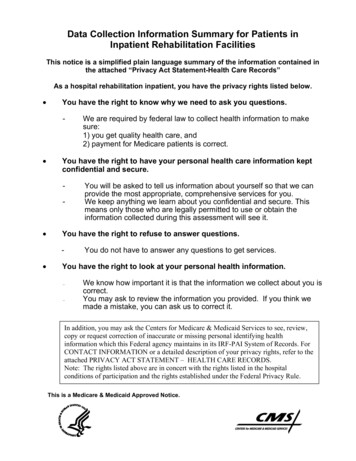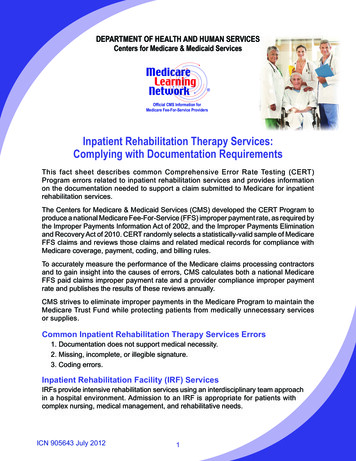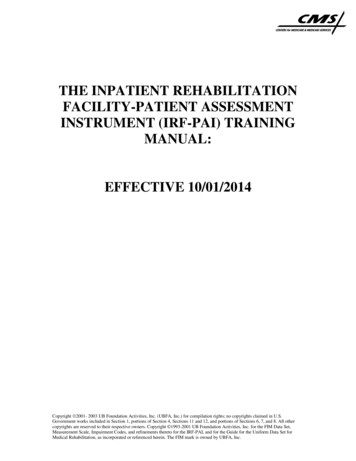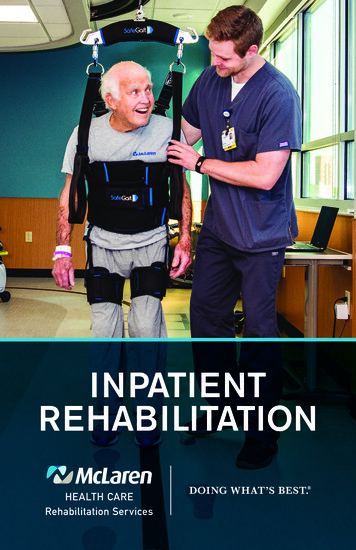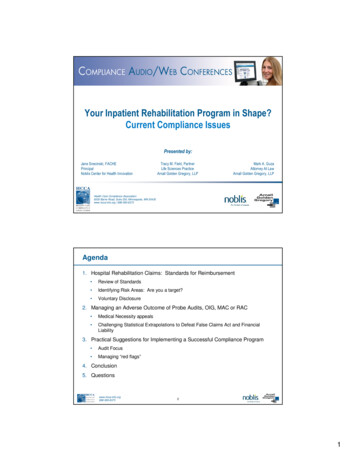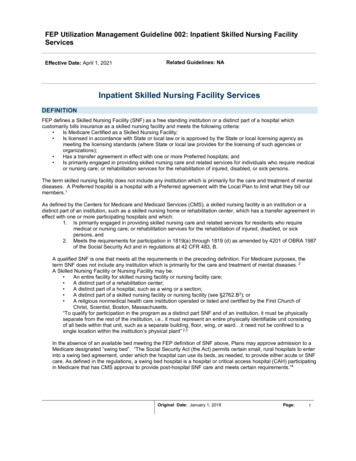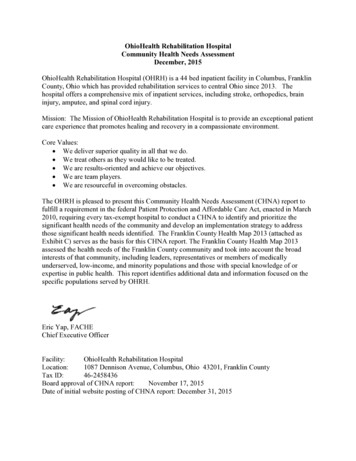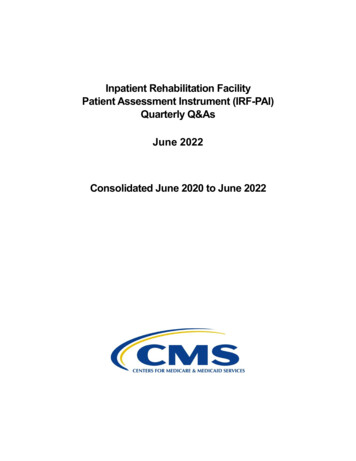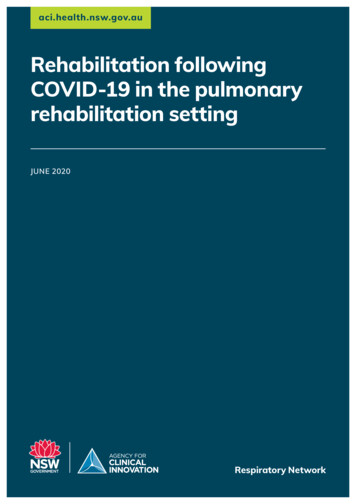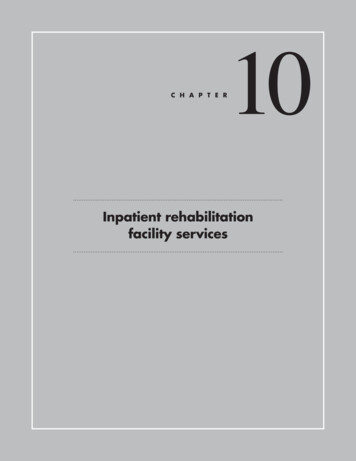
Transcription
C ha p t e r10Inpatient rehabilitationfacility services
RECOMMENDATION10 The Congress should eliminate the update to the Medicare payment rates for inpatientrehabilitation facilities in fiscal year 2016.COMMISSIONER VOTES: YES 17 NO 0 NOT VOTING 0 ABSENT 0
C H A PTE RInpatient rehabilitationfacility servicesChapter summary10In this chapterInpatient rehabilitation facilities (IRFs) provide intensive rehabilitationservices to patients after an injury, illness, or surgery. Rehabilitation programs Are Medicare paymentsadequate in 2015? How should Medicarepayments change in 2016?at IRFs are supervised by rehabilitation physicians and include services suchas physical and occupational therapy, rehabilitation nursing, and speech–language pathology, as well as prosthetic and orthotic devices. In 2013,Medicare spent 6.8 billion on fee-for-service IRF care provided in about1,160 IRFs nationwide. About 338,000 beneficiaries had more than 373,000IRF stays. On average, Medicare fee-for-service accounts for about 61 percentof IRFs’ discharges.Assessment of payment adequacyOur indicators of Medicare payment adequacy for IRFs are generally positive.Beneficiaries’ access to care—Our analysis of IRF supply and volume ofservices provided suggests that capacity remains adequate to meet demand. Capacity and supply of providers—Between 2012 and 2013, the numberof IRFs remained fairly steady at just over 1,160 providers. The numberof hospital-based and nonprofit IRFs continues to decrease, while thenumber of freestanding IRFs and for-profit IRFs continues to increase.However, more than half of the new IRFs that opened in 2013 werehospital-based units. The average IRF occupancy rate has hovered aroundReport to the Congress: Medicare Payment Policy March 2015239
63 percent for the past several years, indicating that capacity is more thanadequate to handle current demand for IRF services. Volume of services—Between 2012 and 2013, the number of Medicare casestreated in IRFs was stable at about 373,000 cases.Quality of care—The Commission tracks three indicators of IRF quality: riskadjusted facility discharge to the community, risk-adjusted discharge to skillednursing facilities (SNFs), and potentially avoidable readmissions to acute carehospitals. All measures showed small improvement between 2011 and 2013. Wealso report on measures of change in patients’ motor function and cognition duringtheir IRF stay. These scores also increased slightly from 2011 to 2013, the periodwe examined.Providers’ access to capital—One major freestanding IRF chain that accountedfor almost 40 percent of all freestanding IRFs in 2013 and about a quarter of allIRF discharges has very good access to capital. We were not able to determine theability of other freestanding facilities to raise capital. The parent institutions ofhospital-based IRFs have maintained reasonable access to capital.Medicare payments and providers’ costs—In 2013, the aggregate Medicare marginremained steady at 11.4 percent, in spite of the sequester. The aggregate marginhas risen steadily since 2009. Financial performance continues to vary acrossIRFs, with margins of freestanding IRFs far exceeding those of hospital-basedfacilities. Higher margins were largely driven by lower unit costs. The lower costsmay stem from greater economies of scale. But freestanding IRFs are also farmore likely than hospital-based units to be for profit and therefore may be morefocused on controlling costs. There are also notable differences in hospital-basedand freestanding IRFs’ mix of cases. The difference in the mix of case types acrossproviders raises questions about patient selection and the relative profitability ofdifferent case types.We project that IRFs’ aggregate Medicare margin will be 12.6 percent in 2015. Thisestimate includes the effect of the sequester. If the sequester were not in effect in2015, our projected margin would be almost 2 percentage points higher.On the basis of these indicators, the Commission concludes that IRFs can continueto provide Medicare beneficiaries with access to safe and effective care with noupdate to the payment rates in fiscal year 2016. Our recommendation assumes thatsite-neutral payments for IRFs and SNFs, which would affect IRF revenues, will notbe implemented in fiscal year 2016 (see Chapter 7). 240Inpatient rehabilitation facility services: Assessing payment adequacy and updating payments
BackgroundAfter illness, injury, or surgery, some patients needintensive, inpatient rehabilitative care, such as physical,occupational, or speech therapy. Such services aresometimes provided in inpatient rehabilitation facilities(IRFs).1 To qualify as an IRF, a facility must meetMedicare’s conditions of participation for acute carehospitals and must be primarily focused on treatingconditions that typically require intensive rehabilitation,among other requirements. IRFs can be freestandingfacilities or specialized units within acute care hospitals.To qualify for a covered IRF stay, a beneficiary must beable to tolerate and benefit from intensive therapy andmust have a condition that requires frequent and faceto-face supervision by a rehabilitation physician. Otherpatient admission criteria also apply. In 2013, Medicarespent 6.8 billion on IRF care provided in about 1,160IRFs nationwide. About 338,000 beneficiaries had morethan 373,000 IRF stays. On average, Medicare accountsfor about 61 percent of IRFs’ discharges.Since January 2002, Medicare has paid IRFs under a perdischarge prospective payment system (PPS).2 Underthe IRF PPS, Medicare patients are assigned to case-mixgroups (CMGs) based on the patient’s primary reasonfor inpatient rehabilitation, age, and level of functionaland cognitive impairment. Within each of these CMGs,patients are further categorized into one of four tiersbased on the presence of specific comorbidities that havebeen found to increase the cost of care. Each CMG tierhas a specific weight that reflects the average relativecostliness of cases in the group compared with that ofthe average Medicare IRF case.3 The CMG weight ismultiplied by a base payment rate that has been adjustedto reflect geographic differences in the wages IRFs pay.The payment is further adjusted based on the share of lowincome patients treated by the IRF. Additional adjustmentsare made for IRFs that are teaching facilities and for IRFslocated in rural areas. The IRF PPS has outlier paymentsfor patients who are extraordinarily costly.4Medicare facility requirements for IRFsTo qualify as an IRF for Medicare payment, facilitiesmust meet the Medicare IRF classification criteria. Thefirst criterion is that providers must meet the Medicareconditions of participation for acute care hospitals. Theymust also: have a preadmission screening process to determinethat each prospective patient is likely to benefitsignificantly from an intensive inpatient rehabilitationprogram; ensure that the patient receives close medicalsupervision and provide—through qualifiedpersonnel—rehabilitation nursing, physical therapyand occupational therapy, and, as needed, speech–language pathology and psychological (includingneuropsychological) services, social services, andorthotic and prosthetic devices; have a medical director of rehabilitation with trainingor experience in rehabilitation who provides servicesin the facility on a full-time basis for freestandingIRFs or at least 20 hours per week for hospital-basedIRF units; use a coordinated interdisciplinary team approachled by a rehabilitation physician that includes arehabilitation nurse, a social worker or case manager,and a licensed therapist from each therapy disciplineinvolved in the patient’s treatment; and meet the compliance threshold (described below).The compliance threshold requires that no less than60 percent of all patients admitted to an IRF haveas a primary diagnosis or comorbidity at least 1 of13 conditions specified by CMS.5 The intent of thecompliance threshold is to distinguish IRFs from acutecare hospitals. If an IRF does not meet the compliancethreshold, Medicare pays for all its cases on the basis ofthe inpatient hospital prospective payment system ratherthan the IRF PPS.The compliance threshold was originally set at 75 percentof an IRF’s cases. But analysis of proprietary data fromeRehabData for a sample of IRFs suggests that, beforeimplementation of the IRF PPS, many facilities fell shortof that threshold. In 2002, the percentage of IRF caseswith 1 of the 13 specified conditions was 42 percent.CMS suspended enforcement of the rule in 2002 becauseof inconsistent enforcement patterns among Medicare’sadministrative contractors, but it began consistentlyenforcing compliance in 2004 and enacted restrictionson some of the qualifying conditions.6 The combinationof renewed enforcement of the threshold and additionalrestrictions resulted in a substantial decline in the volumeof Medicare patients treated in IRFs. As volume declined,occupancy rates, the number of rehabilitation beds, and theReport to the Congress: Medicare Payment Policy March 2015241
number of facilities also fell. Average case-mix severityand cost per case increased as IRFs admitted patientswith more complex conditions who counted toward thethreshold.The compliance threshold was permanently cappedat 60 percent in 2007 by the Medicare, Medicaid, andSCHIP Extension Act of 2007. Since then, the industryhas stabilized. According to eRehabData, 60.3 percentof IRFs’ cases counted toward the compliance thresholdin 2013. Although IRFs’ efforts to meet this compliancethreshold had a significant effect on IRF volume, thedecline was consistent with the underlying reason fortightening enforcement of the compliance threshold—toensure that providers receiving higher IRF payments areprimarily engaged in furnishing intensive rehabilitation toclinically appropriate cases.Determining compliance can be complex. A case is firstevaluated for compliance based on the impairment groupcode (IGC), which describes the primary reason forinpatient rehabilitation.7 (IGCs are also used to assigncases to case-mix groups for payment purposes.) Ifcompliance cannot be determined based on the IGC, thecase is evaluated for compliance based on the patient’sInternational Classification of Diseases, Ninth Revision,Clinical Modification (ICD–9–CM) diagnosis codes.Compliance is evaluated either through medical review orthrough the “presumptive” method, developed by CMS, inwhich a computer program compares a facility’s InpatientRehabilitation Facility–Patient Assessment Instrument(IRF–PAI) assessments from the year with a list of eligiblecodes. The diagnosis codes included on the list are onesthat CMS believes demonstrate either that the patientmeets criteria for the medical conditions that may becounted toward an IRF’s compliance percentage or thatthe patient has a comorbidity that could cause significantdecline in functional ability such that the patient wouldrequire intensive rehabilitation (Centers for Medicare &Medicaid Services 2014).In fiscal year 2016, CMS is removing a large numberof ICD–9–CM codes from the list used to qualify forpresumptive compliance with the 60 percent rule becausethe codes alone do not provide sufficient information thatthe patient would reasonably require intensive inpatientrehabilitation (Centers for Medicare & Medicaid Services2014). Examples include nonspecific or miscellaneousdiagnosis codes and codes for arthritis conditions thatwould meet the compliance criteria only if severity andprior treatment criteria are met, which could be determined242only through medical review. The Commission supports thiseffort and encourages CMS to explore further refinementsof the 60 percent rule to ensure that higher IRF paymentsare made to providers that furnish IRF-level services tobeneficiaries who need and can tolerate that level of care.Medicare coverage criteria for beneficiariesMedicare applies additional criteria that govern whetherIRF services are covered for an individual Medicarebeneficiary. In 2010, CMS clarified coverage criteriaregarding which patients are appropriate to be treatedin an IRF, when therapy must begin, and how and whenbeneficiaries are evaluated. For an IRF claim to beconsidered reasonable and necessary, there must be areasonable expectation that the patient meets the followingrequirements at admission: The patient requires active and ongoing therapy in atleast two modalities, one of which must be physical oroccupational therapy. The patient generally requires and can be reasonablyexpected to actively participate in and benefit fromintensive rehabilitation therapy that most typicallyconsists of three hours of therapy a day at least fivedays a week. The patient is sufficiently stable at the time ofadmission to actively participate in the intensiverehabilitation program. The patient requires supervision by a rehabilitationphysician. This requirement is satisfied by physicianface-to-face visits with a patient at least three days aweek.Are Medicare payments adequate in2015?To assess whether payments for fiscal year 2015 areadequate to cover the costs providers incur and how muchproviders’ costs are expected to change in the comingyear (2016), we examine several indicators of paymentadequacy. Specifically, we assess beneficiaries’ access tocare by examining the capacity and supply of IRFs andchanges over time in the volume of services provided,quality of care, providers’ access to capital, and therelationship between Medicare payments and providers’costs.Inpatient rehabilitation facility services: Assessing payment adequacy and updating payments
TABLE10–1Type of IRFThe number of for-profit IRFs and freestanding IRFs continues to grow,while the number of nonprofit IRFs and hospital-based IRFs declinesShare ofMedicaredischargesAverageannual 0062006–20122012–20130.2%–0.8%–0.4%All 392430.01.61.7Hospital fit50768758738729698677–0.7–1.4–3.0For 71552.2–1.1–1.3GovernmentNote:IRF (inpatient rehabilitation facility). Numbers may not sum to totals because of missing data.Source: MedPAC analysis of Provider of Service files from CMS.Beneficiaries’ access to care: IRF supply andservice volume suggest sufficient accessWe have no direct indicator of beneficiaries’ access toIRF care. There are few clear criteria outlining the needfor such care, so we have no way to determine whetherIRF care is necessary or beneficial for a given patient orwhether another, lower cost post-acute care provider (suchas a skilled nursing facility or a home health agency) couldprovide appropriate care. The absence of IRFs in someareas of the country makes it particularly difficult to assessthe need for IRF care since beneficiaries in areas withoutIRFs presumably receive similar services in other settings.Nevertheless, our analysis of IRF supply and volume ofservices provided suggests that capacity remains adequateto meet demand.Capacity and supply of providers: Number of IRFsand occupancy rates suggest adequate capacityIn 2013, there were 1,161 IRFs nationwide, withmore than 38,000 beds; each state and the District ofColumbia had at least one IRF (Table 10-1). In general,IRFs are concentrated in highly populated states thathave large Medicare populations. More than two-thirdsof beneficiaries live in a county that has at least oneIRF. IRFs are not the sole provider of rehabilitationservices in communities; though they do not necessarilyprovide intensive rehabilitation, skilled nursing facilities(SNFs), home health agencies, comprehensive outpatientrehabilitation facilities, and independent therapy providersalso furnish rehabilitation services. Given the number anddistribution of these other rehabilitation therapy providersrelative to IRFs, it is unlikely that many areas exist whereIRFs are the only provider of rehabilitation therapyservices available to Medicare beneficiaries.In 2013, about 79 percent of IRFs were distinct unitslocated in acute care hospitals; the remaining 21 percentwere freestanding facilities. However, because hospitalbased units tend to have fewer beds, they accounted foronly 53 percent of Medicare discharges from IRFs. Overall,28 percent of IRFs are for-profit entities. Freestanding IRFsare far more likely to be for profit than hospital-based IRFs(68 percent vs. 17 percent). About 41 percent of MedicareIRF discharges in 2013 were from for-profit facilities. Overtime, the number of hospital-based and nonprofit IRFs hasdeclined, while the number of freestanding and for-profitIRFs has increased. Between 2006 and 2013, the numberof hospital-based IRFs fell by 9 percent, while the numberof freestanding IRFs rose 12 percent.In 2013, about 35 IRFs closed; about 80 percent of thesewere hospital-based units. However, almost two-thirds ofthe new IRFs that opened that year were hospital-basedunits. Acute care hospitals may find that IRF units helpreduce inpatient lengths of stay and free up hospital beds foradditional admissions. Previous Commission analyses haveReport to the Congress: Medicare Payment Policy March 2015243
TABLE10–2Number of casesCases per10,000 FFSbeneficiariesSpending(in billions)Payment per caseALOS (in days)UsersNote:The number of fee-for-service IRF cases is holding steadyAverageannual 359,307371,288373,284373,118–7.9 �0.1–0.4 6.6 6.2 5.9 6.1 6.5 6.7 6.8–2.63.21.4 13,290 15,380 16,646 17,085 17,398 17,995 337,704–7.91.2–0.4IRF (inpatient rehabilitation facility), FFS (fee-for-service), ALOS (average length of stay).Source: MedPAC analysis of Medicare Provider Analysis and Review data from CMS.found that hospitals with IRF units have higher inpatientMedicare margins than hospitals without such units.The average IRF occupancy rate has hovered around 63percent for the past several years, indicating that capacityis more than adequate to handle current demand for IRFservices. Freestanding IRFs and IRFs located in urbanareas had somewhat higher average occupancy rates in2013 than did their hospital-based and rural counterparts.Volume of services: Number of IRF cases holdingsteadyThe number of Medicare fee-for-service (FFS) IRF casesgrew rapidly throughout the 1990s and the early years ofthe IRF PPS, reaching a peak of about 495,000 in 2004(Table 10-2). After CMS renewed its enforcement ofthe compliance threshold in 2004, IRF volume declinedsubstantially, falling almost 8 percent per year from 2004to 2008. At that point, volume began to increase slowly.Between 2012 and 2013, volume was stable, remaining atabout 373,000 cases.Since 2008, the number of IRF cases per 10,000 FFSbeneficiaries has held steady at about 100. Relativelyfew Medicare beneficiaries use IRF services because, to244qualify for Medicare coverage, IRF patients must be ableboth to tolerate and benefit from intensive rehabilitationtherapy, which typically consists of at least three hours oftherapy a day for at least five days a week. Still, comparedwith all Medicare beneficiaries, those admitted to IRFs aredisproportionately over age 85. Almost a quarter of IRFs’Medicare cases were for beneficiaries aged 85 or older.The use rate of IRFs among Medicare’s FFS populationcontinues to be more than twice that of the MedicareAdvantage population (see text box, pp. 246–247).Beginning in 2004, after CMS’s renewed enforcementof the compliance threshold and restrictions on someof the qualifying conditions, the total number of IRFcases fell and the mix of cases treated by IRFs shiftedmarkedly. IRFs began to admit a higher share of patientswith diagnoses that met the revised compliance threshold,such as stroke, brain injury, and neurological disorders.The growth in cases with neurological disorders—which include multiple sclerosis, Parkinson’s disease,and polyneuropathy—has been particularly striking.Between 2004 and 2013, the number of IRF cases withneurological disorders grew 82 percent, even as the totalnumber of Medicare IRF cases declined 24 percent. Thenumber of cases with brain injuries rose 58 percent overInpatient rehabilitation facility services: Assessing payment adequacy and updating payments
TABLE10–3IRF patient mix is stable after period of rapid changePercent of IRF MedicareFFS casesCondition2004Percentage point %yes3.9–1.10.0Fracture of the lower gical 1.1Brain injury3.97.37.98.2yes3.40.60.2Other orthopedic conditions5.26.47.57.7no1.31.10.2Cardiac conditions5.34.95.35.4no–0.30.40.1Spinal cord �5.0–0.6–0.1Major joint replacement of the lower extremityAll otherNote:IRF (inpatient rehabilitation facility), FFS (fee-for-service). “Fracture of the lower extremity” includes hip, pelvis, and femur fractures. “Neurological disorders”includes multiple sclerosis, Parkinson’s disease, and polyneuropathy. Patients with debility have generalized deconditioning not attributable to other conditions.“Other orthopedic conditions” excludes fractures of the hip, pelvis, and femur, and hip and knee replacements. “All other” includes conditions such as amputations,arthritis, and pain syndrome. “Meets compliance threshold” indicates whether the condition counts toward the compliance threshold, which requires that 60 percentof all patients have 1 of 13 specified diagnoses. Numbers may not sum to totals due to rounding.*Cases admitted for rehabilitation following major joint replacement of the lower extremity count toward the compliance threshold if joint replacement was bilateral,if the patient had a body mass index of 50 or greater, or if the patient was age 85 or older.**Case types in this category that meet the compliance threshold include congenital deformity, amputation, major multiple trauma, burns, and certain arthritis cases.Source: MedPAC analysis of Inpatient Rehabilitation Facility–Patient Assessment Instruments from CMS.the same period. (Notably, we also observe growth in thenumber of debility cases and cases with other orthopedicconditions, neither of which is among the 13 conditionsthat count toward the compliance threshold.) As a result,neurological disorders now make up 12.4 percent of allIRF cases compared with 5.2 percent in 2004 (Table 10-3).Beneficiaries with brain injuries now make up 8.2 percentof all IRF cases, up from 3.9 percent in 2004.In 2013, the most common case type in IRFs was stroke,accounting for 19.4 percent of Medicare cases (Table10-3). The next most common case types are fracture ofthe lower extremity (12.5 percent of all Medicare cases)and neurological disorders (12.4 percent). However,the distribution of case types differs by type of IRF. Forexample, freestanding for-profit IRFs have a lower share ofstroke cases (14 percent) and a higher share of cases withneurological disorders (19 percent) (Table 10-4).TABLE10–4IRF patient mix differs by provider type, 2013FreestandingConditionAll IRFsFor profitHospital basedNonprofitFor profitNonprofitStroke19%14%22%19%24%Fracture of the lower extremity1413121714Neurological disorders12197108811756Other orthopedic conditionsNote:IRF (inpatient rehabilitation facility). “Neurological disorders” includes multiple sclerosis, Parkinson’s disease, and polyneuropathy. “Fracture of the lower extremity”includes hip, pelvis, and femur fractures. “Other orthopedic conditions” excludes fractures of the hip, pelvis, and femur, and hip and knee replacements.Source: MedPAC analysis of Inpatient Rehabilitation Facility–Patient Assessment Instruments from CMS.Report to the Congress: Medicare Payment Policy March 2015245
Comparison of Medicare Advantage and Medicare fee-for-service patients’ use ofinpatient rehabilitation facility servicesPatients who reside in areas with inpatientrehabilitation facilities (IRFs) typically havealternatives for rehabilitation care, includingskilled nursing facilities and home health agencies.Alternative post-acute care settings are generallyless costly but offer less intensive rehabilitation andmedical services. For many patients, any numberof settings could provide appropriate care for theirconditions. Because Medicare Advantage (MA) planshave incentives to manage care for beneficiaries in acost-efficient manner, we examined how the populationcharacteristics and use rates of the higher cost IRFservices in the MA population compared with use inthe fee-for-service (FFS) population.Medicare requires IRFs to submit patient assessmentdata for both FFS and MA patients. We examined 2013data from the IRF–Patient Assessment Instrumentand found that the use rate of IRFs among the FFSpopulation in 2013 was more than double the rate ofMA patients (Table 10-5). MA enrollees who usedIRFs were more likely than FFS beneficiaries to have(continued next page)Quality of care: Small improvements in riskadjusted measures between 2011 and 2013This year, to assess the quality of care provided in IRFs,the Commission developed and examined risk-adjustedfacility rates of improvement in patients’ functionaland cognitive abilities, discharge to the community anddischarge to SNFs, and potentially avoidable readmissionsto acute care hospitals. We use these measures becausethey reflect the preferences of beneficiaries, the goalsof inpatient rehabilitation care, and the objectives of theMedicare program. Beneficiaries who use IRF servicesare seeking to regain or improve physical and cognitivefunction after an acute event, surgery, or debilitatingmedical problem. Community discharge—return tothe home—is the goal for many. Rates of discharge toa SNF reflect the extent to which patients continue toneed institutional care after the IRF stay. Avoiding costlyand harmful hospital readmissions is beneficial for bothbeneficiaries and the Medicare program.246TABLE1 0 –5FFS beneficiaries have higherIRF use rate, lower severitythan MA enrollees, 2013FFSpatientsMApatientsCases per 1,000 enrollees10.13.8Admitted from acute unit of same facility37.8%43.0%Case-mix weight1.311.38Average LOS (in days)12.813.7Discharged home69.9%72.8%Discharged home with home health52.553.1Discharged to SNF10.98.1Percent:Note:FFS (fee-for-service), IRF (inpatient rehabilitation facility), MA(Medicare Advantage), LOS (length of stay), SNF (skilled nursingfacility). Discharge destinations do not total 100 percent becausepatients in the discharged home category also appear in thedischarged home with home health category. Some dischargedestinations are not shown.Source: MedPAC analysis of Inpatient Rehabilitation Facility–PatientAssessment Instrument data from CMS.To accurately compare quality across facilities, measuresmust be risk adjusted to reflect the relative complexity ofcases each facility treats. Without risk adjustment, somefacilities may appear to provide higher quality care whenin fact they treat a less complex mix of cases, while othersmay appear to have worse quality when in fact they treata more complex mix of cases. Risk adjustment allows forfair comparisons across facilities.Risk-adjusted gains in motor function andcognitionTo qualify for coverage of IRF care, beneficiaries mustrequire, be able to participate in, and benefit fromintensive rehabilitation therapy. To observe the extent towhich IRFs help improve the motor function and cognitionof the beneficiaries they treat, we worked with a contractorto develop a risk-adjusted measure of gains in theseareas. We wanted measures reflecting the extent to whichpatients improved their motor skills and cognition duringInpatient rehabilitation facility services: Assessing payment adequacy and updating payments
Comparison of Medicare Advantage and Medicare fee-for-service patients’ use ofinpatient rehabilitation facility services (cont.)been admitted to the IRF from an acute-care unit of thesame facility (43 percent vs. about 38 percent).On average, as measured by the IRF case-mix weight,MA IRF patients were more complex than their FFScounterparts, and their average stay was almost a daylonger. At the same time, MA IRF patients were morelikely to be discharged home and less likely to bedischarged to a SNF.The mix of case types among MA IRF cases wasdifferent from that among FFS IRF cases (Table 10-6).A much larger share of MA IRF patients were admittedfor rehabilitation after a stroke—34 percent comparedwith 19 percent for FFS IRF patients. MA IRF caseswere also more likely to be admitted because of a braininjury. By contrast, FFS IRF patients were more likelythan MA patients to be admitted for rehabilitation forneurological conditions (12 percent vs. 9 percent) anddebility (10 percent vs. 6 percent).This analysis did not control for the availability of IRFsin areas with high MA market penetration. The use ratecould also be affected by potential differences in theneed for rehabilitation services in the MA population.However, the disparity in use rates suggests that MAplans are more selective in the patients they authorizeto receive care in IRFs. TABLE10–6Mix of case types amongFFS IRF cases differs from thatof MA IRF cases, 2013Share of all casesFFSpatientsMApatientsStroke19%34%Fracture of the lower extremity1310Neurological conditions129Debility106Major joint replacement of thelower extremity99Brain injury810Other orthopedic conditions85Spinal cord injury56Cardiac conditions54Amputation34All other85Type of caseNote:FFS (fee-for-
240 Inpatient rehabilitation facility services: Assessing payment adequacy and updating payments 63 percent for the past several years, indicating that capacity is more than adequate to handle current demand for IRF services. Volume of services—Between 2012 and 2013, the number of Medicare cases treated in IRFs was stable at about 373,000 cases.
